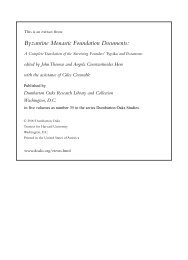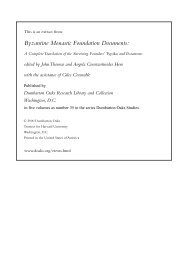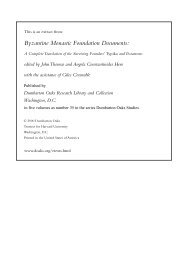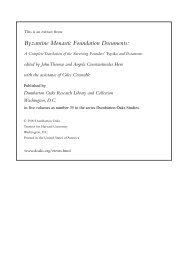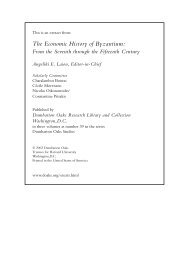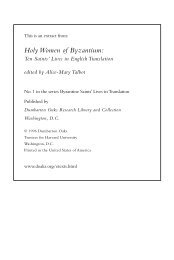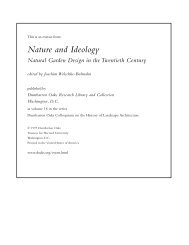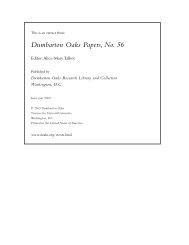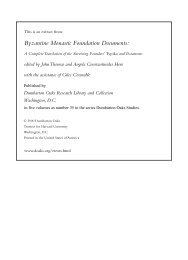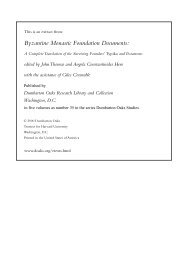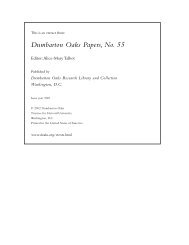Changing Economic Patterns in Latin Romania - Dumbarton Oaks
Changing Economic Patterns in Latin Romania - Dumbarton Oaks
Changing Economic Patterns in Latin Romania - Dumbarton Oaks
You also want an ePaper? Increase the reach of your titles
YUMPU automatically turns print PDFs into web optimized ePapers that Google loves.
David Jacoby [ 205 ]<br />
respect. On the whole, though, prices appear to have been on the rise, 48 except <strong>in</strong> areas<br />
hit by rebellions. 49 The acquisition of these tenements, whether by residents or by newcomers<br />
to the island, was considered a good <strong>in</strong>vestment. 50 In Crete some fiefs provided<br />
<strong>in</strong> the late thirteenth century yearly revenues of more than 1,000 or even 1,500 hyperpers.<br />
51 In the Morea and other feudalized territories, the knight’s fief was supposed to<br />
yield a yearly <strong>in</strong>come of 1,000 hyperpers. 52 The four known figures of the fourteenth<br />
century reflect<strong>in</strong>g the actual revenue of entire knightly fiefs differ widely, two be<strong>in</strong>g<br />
substantially lower. 53 Both <strong>in</strong> feudalized areas and <strong>in</strong> Venetian Crete, military tenements<br />
rema<strong>in</strong>ed for several generations with<strong>in</strong> the same families. In the island, though, they<br />
changed hands more often as a result of greater mobility among military settlers, some<br />
of whom <strong>in</strong> the thirteenth century returned to Venice or other localities <strong>in</strong> Italy after<br />
resid<strong>in</strong>g <strong>in</strong> Crete for a number of years. 54<br />
The redistribution of resources <strong>in</strong> the conquered lands, exam<strong>in</strong>ed above, was coupled<br />
with Lat<strong>in</strong> settlement proceed<strong>in</strong>g on a scale and along patterns unknown earlier <strong>in</strong> <strong>Romania</strong>.<br />
The geographic distribution of the Lat<strong>in</strong> settlers also differed substantially from<br />
what it had been before 1204. These features were bound to have a strong impact on<br />
the economic development of Lat<strong>in</strong> <strong>Romania</strong>. To beg<strong>in</strong> with, there was a swift and<br />
significant growth <strong>in</strong> Lat<strong>in</strong> settlement, encouraged by the new lords, <strong>in</strong>clud<strong>in</strong>g the Venetian<br />
government. To be sure, these lords were eager to strengthen the small Lat<strong>in</strong> nuclei<br />
<strong>in</strong> their respective territories <strong>in</strong> order to <strong>in</strong>crease their military power and enhance their<br />
rule, yet economic considerations were also of major importance <strong>in</strong> this respect. The<br />
collapse of centralized imperial control over specific branches of trade and manufacture,<br />
among them silk, 55 brought about a strik<strong>in</strong>g departure from traditional Byzan-<br />
48 Borsari, Dom<strong>in</strong>io, 83–84, and table fac<strong>in</strong>g 84; Gall<strong>in</strong>a, Società, 106–11. In 1216 Giovanni Longo bought<br />
two militie for 300 Venetian pounds or around 250 hyperpers: R. Morozzo della Rocca and A. Lombardo, eds.,<br />
Documenti del commercio veneziano nei secoli XI–XIII (Tur<strong>in</strong>, 1940) (hereafter DCV ), no. 574; see Jacoby, “Colonisation,”<br />
307 n. 46, for the calculation of this exceptionally low price <strong>in</strong> Cretan currency, and 304–5. Prices<br />
failed to rise around the mid-14th century, presumably <strong>in</strong> connection with the sequels of the Black Death.<br />
49 In 1307 the value of a specific sergeantry <strong>in</strong> the region of Canea was estimated at 300 hyperpers and its annual<br />
revenue at 18 hyperpers, <strong>in</strong> addition to 4 hyperpers paid by each of the ten ville<strong>in</strong> households it conta<strong>in</strong>ed,<br />
thus a total of 58 hyperpers: S. M. Theotokes, ed., jApofásei" Meízono" Sumboulíou Benetía", 1255–1669,<br />
jAkadhmía jAqhnw'n, Mhmei'a th'" JEllhnikh'" JIstoría", tómo" A.2(Athens, 1933), 49, no. 39. Thiriet, Romanie,<br />
273, has mistakenly multiplied by ten the first two figures appear<strong>in</strong>g <strong>in</strong> the document. S<strong>in</strong>ce the sergeantry<br />
was equivalent to one-sixth of a fief, the latter would have yielded around 350 hyperpers. Both its low<br />
value and low revenue may be expla<strong>in</strong>ed by severe damage <strong>in</strong>flicted dur<strong>in</strong>g the rebellion of Alexios Kallergis, as<br />
<strong>in</strong> the case of Lombaro documented for the same year, on which see above, note 22.<br />
50 The evidence <strong>in</strong> this respect contradicts the assumptions of Thiriet, Romanie, 137, and Gall<strong>in</strong>a, Società, 10,<br />
that <strong>in</strong> the 13th century “normal” economic exploitation <strong>in</strong> Crete was excluded, and that rather than be<strong>in</strong>g<br />
concerned with it, the military settlers focused on the establishment and strengthen<strong>in</strong>g of military and <strong>in</strong>stitutional<br />
structures. Incidentally, this was the task of the Venetian authorities.<br />
51 Theotokes, Qespísmata, 1:53, l<strong>in</strong>es 91–106. On revenues, see also Gaspares, Hgh, 264–65, table 13.<br />
52 See Jacoby, “Archontes,” 449 and n. 156.<br />
53 See Carile, Rendita, 118, 126–27, 140–41, 172: revenues of 768 hyperpers <strong>in</strong> return for full yearly military<br />
service, 1,150 for n<strong>in</strong>e months only, 1,165 for three months only, around 743 hyperpers for a whole year.<br />
The reduction of military service <strong>in</strong> the second and third cases was clearly granted as a favor on a personal basis.<br />
54 On the fate of some Cretan fiefs, see Gall<strong>in</strong>a, Vicende, 28 and 55–57, appendix, tables i–iii. On non-<br />
Venetians and the return to Italy, see Jacoby, “Colonisation,” 307, 313.<br />
55 On which see D. Jacoby, “Silk <strong>in</strong> Western Byzantium before the Fourth Crusade,” BZ 84–85 (1991–92):<br />
452–500; repr. <strong>in</strong> idem, Trade, Commodities and Shipp<strong>in</strong>g <strong>in</strong> the Medieval Mediterranean (Aldershot, 1997), no. vii.




